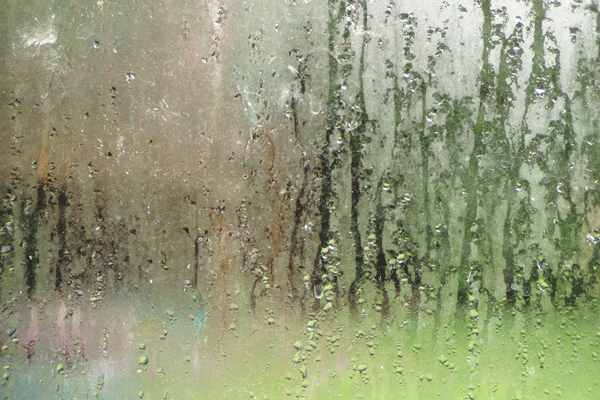Condensation, also called sweating, forms on building materials when the temperature drops below the dew point, which is the temperature at which droplets of water vapor are forced so closely together that they coalesce into liquid water. Because of their characteristic thermal conductivity, components made of metal are usually the first places where condensation will appear in a building.
Condensation can be a problem because droplets can pool and destroy building materials, such as when condensed water chronically drains from a toilet and weakens the bathroom tile floor and subfloor. Condensation can also pool and encourage the growth of mold, which is a serious health hazard. Dripping overhead pipes can be an extreme annoyance in a finished basement, as they may damage carpets, furniture and valuable electronics. Pooled condensation can even cause an electrical fire, or electrocute building occupants.
Where does condensation typically form?
Plumbing drains. Condensation may collect on cast-iron or copper drain piping if a leaking plumbing fixture sends cold water through the building’s drain piping system;
Cold water pipes. In humid environments, condensation will quickly form on water pipes that distribute cold water;
Water pressure tanks. Especially in more humid climates, water pressure tanks may experience condensation when water is flowing at a high & steady rate
In HVAC ducts due to improper installation, like 45 and 90 degree bends or sagging duct lines. I have actually poked a hole in flex ducts and had over 2 gallons of water pour out of them.

Condensation can lead to MOLD!
Double-pane windows have a layer of gas (usually argon or air) trapped between two panes of glass that acts as insulation to reduce heat loss through the window. Other types of gas used in this space have various effects on heat gain or loss through the window. Some windows also have a thin film installed between panes that separates the space between the panes into two spaces, further reducing heat loss and heat gain through the window. If multiple-pane windows appear misty or foggy, it means that the seal protecting the window assembly has failed.
This can lead to Mold and all sorts of problems and issues. If you suspect condensation issues, it is recommended that a professional inspection be performed to confirm the source of the moisture and corrective action can be taken.ed so closely together that they coalesce into liquid water. Because of their characteristic thermal conductivity, components made of metal are usually the first places where condensation will appear in a building.
Condensation can be a problem because droplets can pool and destroy building materials, such as when condensed water chronically drains from a toilet and weakens the bathroom tile floor and subfloor. Condensation can also pool and encourage the growth of mold, which is a serious health hazard. Dripping overhead pipes can be an extreme annoyance in a finished basement, as they may damage carpets, furniture and valuable electronics. Pooled condensation can even cause an electrical fire, or electrocute building occupants.
Where does condensation typically form?
Plumbing drains. Condensation may collect on cast-iron or copper drain piping if a leaking plumbing fixture sends cold water through the building’s drain piping system;
Cold water pipes. In humid environments, condensation will quickly form on water pipes that distribute cold water;
Water pressure tanks. Especially in more humid climates, water pressure tanks may experience condensation when water is flowing at a high & steady rate
In HVAC ducts due to improper installation, like 45 and 90 degree bends or sagging duct lines. I have actually poked a hole in flex ducts and had over 2 gallons of water pour out of them.
Double-pane windows have a layer of gas (usually argon or air) trapped between two panes of glass that acts as insulation to reduce heat loss through the window. Other types of gas used in this space have various effects on heat gain or loss through the window. Some windows also have a thin film installed between panes that separates the space between the panes into two spaces, further reducing heat loss and heat gain through the window. If multiple-pane windows appear misty or foggy, it means that the seal protecting the window assembly has failed.
This can lead to Mold and all sorts of problems and issues. If you suspect condensation issues, it is recommended that a professional inspection be performed to confirm the source of the moisture and corrective action can be taken.
